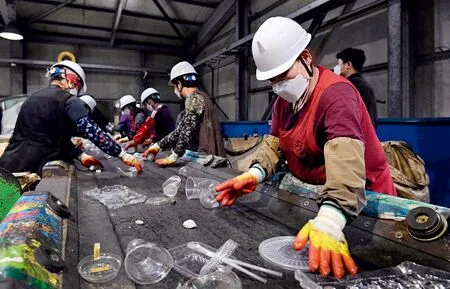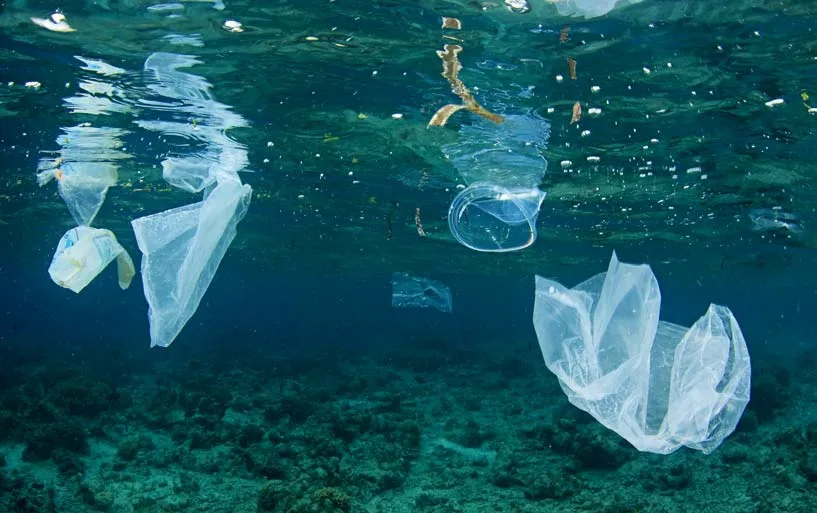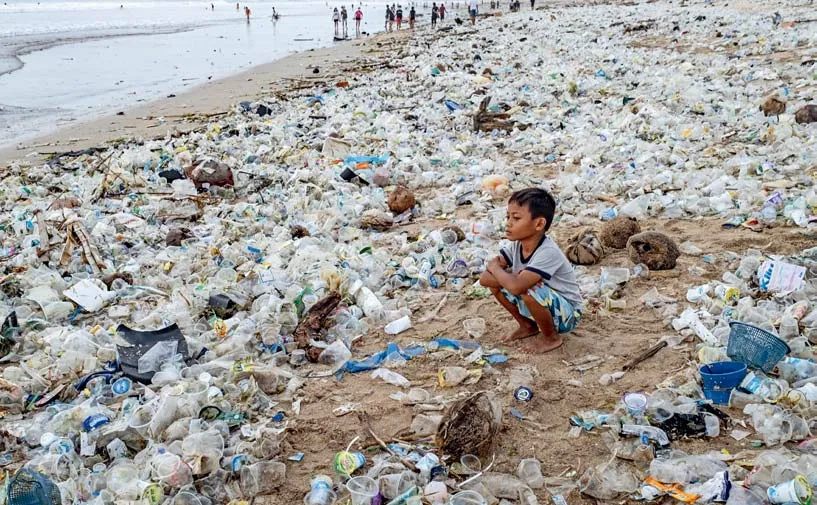Saving The Ocean From Plastic Humans are grappling with the growing plastic mess in the oceans
2023-01-18ByGuoXixian
By Guo Xixian
O n March 16, 2019, the body of a male whale calf was spotted in Davao Bay, the Philippines. Scientists discovered about 40 kilograms of plastic waste in its stomach, much of which was hardened. The plastic waste had occupied the space in the calf’s stomach for a long time, so that it starved to death without enough food and water.
This kind of news is nothing new, but the scenes are always horrifying. Since its inception in the 1950s, plastic has been produced exponentially and discharged into the oceans through multiple channels. Plastic waste has gradually become the marine debris with the largest quantity, which can do the greatest harm in the long run.
In March 2022, the resumed fifth session of the UN Environment Assembly (UNEA-5) adopted a historic resolution titled “End Plastic Pollution: Towards an internationally legally binding instrument,” with the goal of forging a legally binding global treaty by 2024 to end plastic pollution. The resolution underlined the importance of promoting sustainable design of products and materials so that they can be reused, remanufactured, or recycled and therefore retained in the economy for as long as possible along with the resources they are made of, as well as minimizing the generation of waste. The first round of intergovernmental negotiations on the subject began in November.
Harmful Invention
Plastics, once known as “one of the greatest inventions of the 20th century,” have brought tremendous changes to human life, but at a tremendous cost.

A plastics recycling plant in Hoengseong, South Korea. The polyethylene terephthalate (PET) in the plastics can be recycled to make clothes. (VCG)
Data released by the United Nations Environment Programme (UNEP) in 2021 showed that about 8.3 billion tons of plastics had been produced worldwide. Production has more than quadrupled in the last four decades, but less than 10 percent of all products have been recycled. Nearly 100 million tons of plastic waste is in the oceans. Every year, around 9-14 million tons of plastics continue to be poured into the oceans, accounting for 85 percent of all marine debris, with a rising percentage year on year. By 2040, 23-37 million tons of plastics are expected to reach the oceans annually.
A huge volume of plastic products, such as fibers, building materials, and takeaway bags end up in the oceans through garbage landfills, sewage treatment plants, and particles in the air after incineration. According to a report released by the Worldwide Fund for Nature (WWF) in October 2021, land-based garbage improperly treated accounts for over 70 percent of all marine debris. River input is the most dominant route, with about 0.8-2.7 million tons of plastic waste being discharged into the oceans every year. In addition, plastic waste leakage from marine transport, fishery, and aquaculture accounts for a small proportion of the total.
Ji Junhui, director of the National Engineering Research Center of Engineering Plastics under the Chinese Academy of Sciences, believes that if action is not taken to address the situation, by 2050, plastics will likely outweigh marine life in the oceans.
At present, at least one marine debris belt can be found in each ocean, the largest being the North Pacific Ocean Debris Belt, covering an area of 1.6 million square kilometers, which is equivalent to the entire area of Mongolia.
With its rapid economic growth, dense population, long coastline, and insufficient waste treatment capacity, Southeast Asia has become a key region for marine plastic pollution control.
Ji Junhui said that as the most densely populated region in the world, Southeast Asia has grown in plastic consumption with rapid economic development. However, regional countries’ garbage treatment systems could hardly cope with the situation. Marine plastic reduction has become a problem that cannot be ignored by any country in the region.
Plastic waste does the most obvious damage to marine life. The survival of fish and marine birds is threatened by the risk of plastic entanglement and ingestion, and microorganisms and coral on the seabed could die from sunshine being obscured by plastic waste.
In addition, microplastics are easily ignored by humans but can do great harm. Microplastics can be found in the crystals in toothpaste and detergent, the fibers on the surface of clothes, and the particles decomposed under the action of seawater erosion and sunshine exposure. Microplastics are readily diffusible, but undetectable to the naked eye. They are taken to all corners of the Earth by ocean currents. In microplastic hotspots, the seafloor can contain 1.9 million plastic particles per square meter.
Chen Yuan, director of regional chemical management at the UNEP Basel Convention Regional Center for Asia and the Pacific, said that microplastics can absorb and carry pollutants from the environment and accumulate with the extension of the food chain, posing a threat to human health ultimately.
Pressing Challenge
An increasing amount of plastic waste is being poured into the oceans. To curb marine plastic pollution, it is necessary to first prevent the accumulation of plastic debris. Sustainability should be a key concept in the whole life cycle of plastic design, production, and consumption.
“Overuse can be brought under control,” said Ji Junhui, “but there’s no way to prevent the use of plastic products.” Plastics have penetrated every corner of human life. Degradable plastics as an alternative can help effectively control plastic pollution at the front end of the industry chain.
The main degradable plastics available now include Polylactic Acid (PLA), Polybutanedioic Acid Butanediol Ester (PBS), and Polybutylene Adipate Terephthalate (PBAT), which can be decomposed and digested by microorganisms into carbon dioxide and water eventually. At the 2022 Beijing Olympic Winter Games, PLA tableware and PBAT bags were widely used. Indonesia has produced food packaging bags made from seaweed, and South Korea has produced edible straws made of rice.
But what is degradable on land is not necessarily degradable in seawater. Ji Junhui explained that application scenarios for degradable plastics are severely limited. In contrast to the environment on land, microorganisms in seawater are negligible and the temperature is fairly low, making it more difficult for existing degradable plastics to contribute to marine plastic reduction.
After careful consideration of the problem, Ji Junhui and his team have been working on a solution since 2017. Their R&D efforts have resulted in degradable plastics in all natural domains. Innovation starts with the design of molecular structure of this kind of new material. The properties and appearance of the original plastics have been retained. What makes the difference is that they are degradable in both seawater and soil on land. This new technology can be applied to the production of major plastic products like fishing nets, plastic bags, and plastic bottles. At present, the development of this technology has entered the intermediate stage of testing for commercial application in the future.
Ji Junhui said that degradable plastics in all natural domains are not a new generation of degradable plastics, but a brand-new disruptive technology. Improvement of technology and reduction of cost will create greater space for development. At the same time, he thinks that plastic product alternatives will have to match the original products in function, cost, and production scale. It will be a long process that requires continuous efforts.
In the consumption link, countries have introduced deposits, fines, taxes, and other policies to restrict the use of plastics, with their focus on the most common single-use plastic products.
Sustainability should be a key concept in the whole life cycle of plastic design, production, and consumption.

Plastic pollution in the ocean. (RICHARD CAREY)
In 2019, the European Commission adopted the Single-Use Plastics Directive, which banned production of 10 most commonly found disposable plastic products, and even degradable plastics, such as single-use tableware and beverage bottles. The reason for imposing such a strict ban was that the existing degradable plastics cannot solve the problem of marine plastic pollution.

A boy sits on a beach littered with plastic waste in Bali, Indonesia, on December 31, 2020. (MADE NAGI)
ASEAN countries have held several international conferences and signed statements on marine plastic reduction. They have also introduced relevant measures to restrict the use of plastic products. In 2020, China released Guidelines on Further Strengthening the Control of Plastic Pollution, which imposed restrictions on usage of a variety of nondegradable single-use plastic products including tableware and plastic bags. The guidelines became known in the industry as “the strictest plastic bans in history.”
Chen Yuan said that the main ways to reduce the accumulated stock of plastics in the oceans include strictly managing land-based plastic waste, standardizing maritime operations, improving the eco-friendly design of plastic products in the upstream, and reducing the consumption of plastics, especially single-use plastics, in the midstream. It is also particularly important to improve the awareness and enthusiasm of the general public to participate in plastic reduction.
Long Way to Go
Facing the existing huge amount of marine plastic debris, recycling is necessary, but problems in reality remain.
Chen Yuan said that since the plastic waste in the oceans degrades very slowly, it is necessary to remove it with manual labor, which is no easy job and costs a lot. So far, no major operation has sought to remove plastic waste from the oceans. At the same time, due to a lack of a standard marine plastic debris collection and transfer system, most marine plastic debris that is retrieved still cannot be processed properly.
“Humans have no idea what to do about the plastic in the oceans,” exclaimed Ji Junhui.
At present, the mainstream plastic waste treatment methods include mechanical crushing, incineration for power generation, thermal decomposition, and solvent decomposition. Some scientists have also found upgraded versions of marine microorganisms that can effectively degrade a variety of plastics in seawater. However, academia has expressed concerns about whether the application of such microorganisms could damage existing infrastructure and underwater pipelines in the oceans, whether they would be too costly to be applied at an industrial scale, and other issues.
Not all plastics can be recycled for new purposes. Ji Junhui explained the three kinds of difficulties at this stage: First, it is not economical to recycle plastic bags, plastic foam, and other cheap products. Second, products that have been exposed to toxic and harmful substances such as paint containers and pesticide containers cannot be recycled. Third, some plastics cannot be recycled due to a lack of technical means like the undetectable yet omnipresent microplastics in the oceans.
Zhang Yanfeng, vice dean for scientific research at the School of Chemistry of Xi’an Jiaotong University, said in an interview that the plastics needing recycling are complicated in nature. Many products are made of more than one kind of raw material, and the manufacturing process of some products has made subsequent recycling impossible. “It’s not a problem of technology, but a problem of reality,” he said. “It will take decades or centuries to solve the problem.”
To deal with marine plastic debris properly, it is necessary to consider the full life cycle of plastics. Stakeholders must recognize opportunities to reuse and recycle plastics at the initial stage of design, develop degradable technology, and perform better classification at the source. Focus must be placed on diverse methods to control plastic pollution and forming a plastic waste recycling network as well as an industrial chain. At the same time, work must be done to improve the awareness of the general public on plastic restrictions, cultivate a new culture of environmental protection, and reduce generation of plastic pollution on the consumer side.
Espen Barth Eide, president of UNEA-5, suggested it is high time to incorporate plastics into the circular economy and adopt a legally binding pact to end the crisis of plastic pollution.
Chen Yuan said that the beginning of intergovernmental negotiations on ending plastic pollution marked the commencement of official discussions among countries on systemic solutions for plastic pollution. The movement requires breakthroughs in capital, technology, and policy to achieve the goal of zero growth in marine plastic debris, so as to control plastic pollution from each link of the full life cycle in practical ways.
Ji Junhui believes that marine plastic reduction is an issue for all of society and mankind. Everyone must recognize its importance and shoulder their responsibilities.
杂志排行
China Report Asean的其它文章
- Capturing ‘Ghost Gear’Discarded fishing gear continues to “fish” as the ocean’s silent killer
- Ending Plastic Pollution
- Embracing The ‘Asian Moment’
- CELEBRATING THE 55TH ANNIVERSARY OF ASEAN China and ASEAN pursue common development through solidarity and mutual assistance
- CHINA’S NEW ECONOMY TAKES OFF The goal is to build a modern socialist economy with Chinese characteristics
- A Century of Chinese Animation Drawing a path with Chinese characteristics
